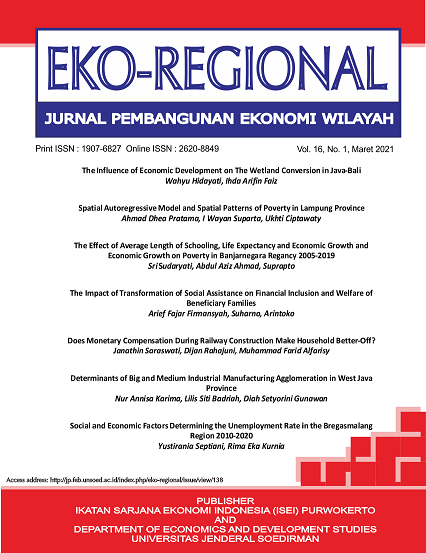Spatial Autoregressive Model and Spatial Patterns of Poverty In Lampung Province
DOI:
https://doi.org/10.20884/1.erjpe.2021.16.1.1776Abstract
Many research in economics only focus on the independence of a region while neglecting the effects of space and the interaction that occurs between mutually adjacent areas. The purpose of this study is to measure the multidimensional poverty concept in 15 districts/cities in the province of Lampung in 2015-2019. Spatial analysis such as moran i statistics, LISA clustered map, and lisa signification are used to analyze spatial patterns and spatial autocorrelation. Spatial modeling with spatial autoregressive model, geoda and geographical information systems are used as explanatory spatial data and spatial modeling. The results show that the percentage of poor people between districts/cities in Lampung Province have positive Moran's I values, there is a clustered pattern in 2015-2019, Moran scatter plot depicts 4 quadrants, LISA Cluster map indicates high-high and low-low areas, and LISA map has 4 significant areas. Spatial regression results show that per capita expenditure for nonfood has a negative effect, per capita expenditure for food has a positive effect, population growth rate has a positive effect, household clean water has a positive effect, life expectancy has a negative effect, mean years of schooling has a negative effect, and simultaneously the independent variables have a significant influence on the percentage of poor people. Poverty in Lampung Province is spatially related to each other between regions, the findings suggest that the variables used affect spatially. The implication of this result is one of the basis for inter-regional policies in the interests of multi-dimensional poverty alleviation between regions.
Keywords: Poverty, Spatial analysis, Spatial Autoregressive Model (SAR)
References
Akinyemi, FO, and F. Bigirimana. 2012. “A SPATIAL ANALYSIS OF POVERTY IN KIGALI, RWANDA USING INDICATORS OF HOUSEHOLD LIVING STANDARD.” Rwanda Journal 26(1):3–22. doi: 10.4314/rj.v26i1.1.
Anselin, Luc. 1995. “LOCAL INDICATORS OF SPATIAL ORGANIZATION -LISA.” Geographical Analysis 27(2):93–115.
Anselin, Luc. 1998. “SPATIAL ECONOMETRICS: METHODS AND MODELS by L. Anselin.” Journal Spatial Econometric 7(2):1–16.
Anselin, Luc. 2010. “THIRTY YEARS OF SPATIAL ECONOMETRICS.” Papers in Regional Science 89(1):3–25. doi: 10.1111/j.1435-5957.2010.00279.x.
Bird, Kate, Kate Higgins, Dan Harris, Kate Bird, Kate Higgins, and Dan Harris. 2010. SPATIAL POVERTY TRAPS AN OVERVIEW. © Overseas Development Institute 2010.
HASIBUAN, LAILAN SAFINA. 2020. “ANALISIS POLA PENGELUARAN RUMAH TANGGA MISKIN DI KABUPATEN SIMALUNGUN.” Fakultas Ekonomi Universitas Muhammadiyah Sumatera Utara 3(1):58–65.
Irhamni. 2018. “PENGARUH JUMLAH PENDUDUK, PENGANGGURAN, DAN PENGELUARAN PEMERINTAH TERHADAP KEMISKINAN DI INDONESIA TAHUN 1986-2015 Irhamni.” Pendidikan Dan Ekonomi 7(1):88–97.
Jay, Lee, Wiley, Jossey-Bass, Pfeiffer, Lasser, and Capstone. 2001. STATISCAL ANALYSIS WITH ARCVIEW GIS. edited by I. John Wiley & Sons. Canada: John Wiley & Sons, Inc. All rights reserved.Published simultaneously in Canada.
Kim, Sukkoo. 2008. SPATIAL INEQUALITY AND ECONOMIC DEVELOPMENT : Theories , Facts , and Policies. 16.
Massaid, A., M. Hanif, D. Febrianti, and N. Chamidah. 2019. “MODELLING OF POVERTY PERCENTAGE OF NON-FOOD PER CAPITA EXPENDITURES IN INDONESIA USING LEAST SQUARE SPLINE ESTIMATOR.” IOP Conference Series: Materials Science and Engineering 546(5). doi: 10.1088/1757-899X/546/5/052044.
Niswati, Khurri. 2014. “FAKTOR-FAKTOR YANG MEMPENGARUHI KEMISKINAN DI DAERAH ISTIMEWA YOGYAKARTA TAHUN 2003-2011.” Pembangunan Ekonomi Wilayah 9(2):82–89.
Qurratu’ain, Almira Qattrunnada, and Vita Ratnasari. 2016. “ANALISIS INDIKATOR TINGKAT KEMISKINAN DI JAWA TIMUR MENGGUNAKAN REGRESI PANEL.” Jurnal Sains Dan Seni ITS 5(2):265–70.
River, Francisco, Stephen A. Vosti, and Marco P. Maneta. 2011. “SPATIAL PATTERNS OF RURAL POVERTY :” Nova Economia_Belo Horizonte_21 (1)_45-66_janeiro-Abril de 2011 21(1):45–66.
Sakinah, Nur, and Hary Pudjianto. 2018. “DETERMINANTS OF POVERTY IN EAST JAVA METROPOLITAN AREA IN 2010-2016.”Eko-Regional Jurnal Pengembangan Ekonomi Wilayah 13(2):32–40. doi: 10.20884/1.erjpe.2018.13.2.1171.
Sen, Amartya. 1976. “POVERTY: AN ORDINAL APPROACH TO MEASUREMENT.” Econometrica 44(2):219. doi: 10.2307/1912718.
Zhukov, Yuri M. 2010. APPLIED SPATIAL STATISTICS IN R , Section 4 Spatial Point Processes Spatial Data and Basic Visualization in R.





